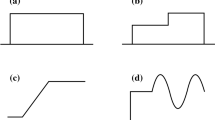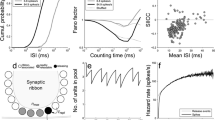Abstract
A fundamental inequality governing the spike activity of peripheral neurons is derived and tested against auditory data. This inequality states that the steady-state firing rate must lie between the arithmetic and geometric means of the spontaneous and peak activities during adaptation. Implications towards the development of auditory mechanistic models are explored.


Similar content being viewed by others
References
Achard P, De Schutter E (2006) Complex parameter landscape for a complex neuron model. PLoS Comput Biol 2(7):e94
Almog M, Korngreen A (2016) Is realistic neuronal modeling realistic? J Neurophysiol 116(5):2180
Benda J, Herz AV (2003) A universal model for spike-frequency adaptation. Neural Comput 15(11):2523
Benda J, Tabak J (2014) Spike-frequency adaptation. Encycl Comput Neurosci 667:1
Bruce IC, Erfani Y, Zilany MS (2018) A phenomenological model of the synapse between the inner hair cell and auditory nerve: implications of limited neurotransmitter release sites. Hear Res 360:40
Brunel N (2010) Modeling point neurons: from Hodgkin–Huxley to integrate-and-fire. In: De Schutter E (ed), Computational modeling methods for neuroscientists. MIT Press, chap. 7, pp 161–185
Carney LH (1993) A model for the responses of low-frequency auditory-nerve fibers in cat. J Acoust Soc Am 93(1):401
Dyson F (2004) A meeting with Enrico Fermi. Nature 427(6972):297
Eggermont J (1973) Analog modelling of cochlear adaptation. Kybernetik 14(2):117
Enroth-Cugell C, Shapley R (1973) Adaptation and dynamics of cat retinal ganglion cells. J Physiol 233(2):271
Fay RR (1978) Coding of information in single auditory-nerve fibers of the goldfish. J Acoust Soc Am 63(1):136
Gamez D (2012) From Baconian to Popperian neuroscience. Neural Syst Circuits 2(1):1
Gutenkunst RN, Waterfall JJ, Casey FP, Brown KS, Myers CR, Sethna JP (2007) Universally sloppy parameter sensitivities in systems biology models. PLoS Comput Biol 3(10):e189
Heil P, Peterson AJ (2015) Basic response properties of auditory nerve fibers: a review. Cell Tissue Res 361(1):129
Heil P, Neubauer H, Irvine DR (2011) An improved model for the rate-level functions of auditory-nerve fibers. J Neurosci 31(43):15424
Heinz MG, Zhang X, Bruce IC, Carney LH (2001) Auditory nerve model for predicting performance limits of normal and impaired listeners. Acoust Res Lett Online 2(3):91
Herz AV, Gollisch T, Machens CK, Jaeger D (2006) Modeling single-neuron dynamics and computations: a balance of detail and abstraction. Science 314(5796):80
Hewitt MJ, Meddis R (1991) An evaluation of eight computer models of mammalian inner hair-cell function. J Acoust Soc Am 90(2):904
Hildebrandt KJ, Benda J, Hennig RM (2009) The origin of adaptation in the auditory pathway of locusts is specific to cell type and function. J Neurosci 29(8):2626
Kandel ER, Schwartz JH, Jessell TM, Siegelbaum SA, Hudspeth AJ (eds) (2013) Principles of neural science. McGraw-Hill
Meddis R (2023) MATLAB model of auditory periphery (MAP). https://github.com/rmeddis/MAP, Last accessed on 05-01
Meddis R (1986) Simulation of mechanical to neural transduction in the auditory receptor. J Acoust Soc Am 79(3):702
Meddis R (1988) Simulation of auditory-neural transduction: further studies. J Acoust Soc Am 83(3):1056
Meddis R, Hewitt MJ, Shackleton TM (1990) Implementation details of a computation model of the inner hair-cell auditory-nerve synapse. J Acoust Soc Am 87(4):1813
Müller M, Robertson D (1991) Relationship between tone burst discharge pattern and spontaneous firing rate of auditory nerve fibres in the guinea pig. Hear Res 57(1):63
Norwich KH (1977) On the information received by sensory receptors. Bull Math Biol 39(4):453
Norwich KH (1993) Information, sensation, and perception. Academic Press, San Diego
Norwich KH, Wong W (1995) A universal model of single-unit sensory receptor action. Math Biosci 125(1):83
O’Leary T, Sutton AC, Marder E (2015) Computational models in the age of large datasets. Current Opin Neurobiol 32:87
O’Mard LP (2023) Development system for auditory modelling (DSAM). http://dsam.sourceforge.net/downloads.htm, Last accessed on 05-01
Peterson AJ, Heil P (2020) Phase locking of auditory nerve fibers: the role of lowpass filtering by hair cells. J Neurosci 40(24):4700
Peterson AJ, Heil P (2021) A simplified physiological model of rate-level functions of auditory-nerve fibers. Hear Res 406:108258
Relkin EM, Doucet JR (1991) Recovery from prior stimulation. I: relationship to spontaneous firing rates of primary auditory neurons. Hear Res 55(2):215
Rhode WS, Smith PH (1985) Characteristics of tone-pip response patterns in relationship to spontaneous rate in cat auditory nerve fibers. Hear Res 18(2):159
Schroeder M, Hall J (1974) Model for mechanical to neural transduction in the auditory receptor. J Acoust Soc Am 55(5):1055
Shimazaki H, Shinomoto S (2007) A method for selecting the bin size of a time histogram. Neural Comput 19(6):1503
Smith R, Brachman M (1982) Adaptation in auditory-nerve fibers: a revised model. Biol Cybern 44(2):107
Smith RL, Zwislocki J (1975) Short-term adaptation and incremental responses of single auditory-nerve fibers. Biol Cybern 17(3):169
Sumner CJ, Palmer AR (2012) Auditory nerve fibre responses in the ferret. Eur J Neurosci 36(4):2428
Sumner CJ, Lopez-Poveda EA, O’Mard LP, Meddis R (2002) A revised model of the inner-hair cell and auditory-nerve complex. J Acoust Soc Am 111(5):2178
Sumner CJ, Lopez-Poveda EA, O’Mard LP, Meddis R (2003) Adaptation in a revised inner-hair cell model. J Acoust Soc Am 113(2):893
Wang YC, Rudi J, Velasco J, Sinha N, Idumah G, Powers RK, Heckman CJ, Chardon MK (2022) Multimodal parameter spaces of a complex multi-channel neuron model. Front Syst Neurosci 16:999531
Westerman LA, Smith RL (1984) Rapid and short-term adaptation in auditory nerve responses. Hear Res 15(3):249
Westerman LA, Smith RL (1988) A diffusion model of the transient response of the cochlear inner hair cell synapse. J Acoust Soc Am 83(6):2266
Wong W (1997) On the physics of perception. Ph.D. thesis, University of Toronto
Wong W (2013) Perceptual arrow of time and the sensory transduction process. arXiv:1307.6445v1
Wong W (2020) On the rate coding response of peripheral sensory neurons. Biol Cybern 114(6):609
Wong W (2021) Consilience in the peripheral sensory adaptation response. Front Hum Neurosci 15:727551
Yates GK, Robertson D, Johnstone BM (1985) Very rapid adaptation in the guinea pig auditory nerve. Hear Res 17(1):1
Zhang X, Carney LH (2005) Analysis of models for the synapse between the inner hair cell and the auditory nerve. J Acoust Soc Am 118(3):1540
Zhang X, Heinz MG, Bruce IC, Carney LH (2001) A phenomenological model for the responses of auditory-nerve fibers: I. Nonlinear tuning with compression and suppression. J Acoust Soc Am 109(2):648
Zilany MS, Bruce IC, Nelson PC, Carney LH (2009) A phenomenological model of the synapse between the inner hair cell and auditory nerve: long-term adaptation with power-law dynamics. J Acoust Soc Am 126(5):2390
Zilany MS, Bruce IC, Carney LH (2014) Updated parameters and expanded simulation options for a model of the auditory periphery. J Acoust Soc Am 135(1):283
Acknowledgements
This work was supported by a Discovery Grant from the Natural Sciences and Engineering Research Council of Canada (NSERC).
Author information
Authors and Affiliations
Contributions
WW conceived and conducted the research, and wrote the manuscript.
Corresponding author
Ethics declarations
Conflict of interest
The author declares no conflict of interest.
Additional information
Communicated by Benjamin Lindner.
Publisher's Note
Springer Nature remains neutral with regard to jurisdictional claims in published maps and institutional affiliations.
Supplementary Information
Below is the link to the electronic supplementary material.
Appendices
Appendix A: Computer code to solve for adaptation response
The following code was developed for the MATLAB programming environment (MathWorks, version R2023a) but can be easily adapted to any other language to solve (1)–(4) numerically with only a few lines of code. The parameters can be set to any positive value. A forward Euler method is used to solve the differential equation in (4).

While the above code was developed to solve for the adaptation response, a simple change to the line governing the stimulus allows for the code to solve the response to any time-varying input. For the example illustrated in the code, note that \(\text {SR}=0.35\), \({\text {PR}}=1.15\) and \({\text {SS}}=0.75\) satisfy the upper bound of the inequality (13).
Appendix B: Slope of steady-state activity at low intensities
There is an alternative way to express (13): for low intensities, the slope of steady-state activity SS with respect to \(\bar{k}\) equals one-half the slope of peak activity PR. We will now prove this assertion. Consider differentiable functions f(x), g(x) and h(x) defined over the domain \(x \ge 0\) satisfying the inequality \(f(x) \le g(x) \le h(x)\) for all non-negative values of x. Moreover, impose the conditions \(f(0)=g(0)=h(0)=y_0\) and \(f'(0)=h'(0)\). \(f'\) designates the first derivative of f with respect to x, etc. Clearly these statements are equivalent to \(g'(0)=f'(0)=h'(0)\) by the definition of the derivative.
Next we recast the problem in terms of SS, PR and SR. In this case, intensity replaces x and \(\text {GM}(0)={\text {SS}}(0)=\text {AM}(0)=\text {SR}\) where AM and GM refer to the arithmetic and geometric means of SR and PR. That is, at zero intensity both the GM and AM equals SR. Moreover since SR is constant with respect to intensity, both \(\text {AM}'(0)\) and \(\text {GM}'(0)\) equals \({\text {PR}}'(0)/2\). By the same steps as before, we conclude that \({\text {SS}}'(0)=\text {AM}'(0)=\text {GM}'(0)={\text {PR}}'(0)/2\). Therefore, the slope of SS equals one-half the value of PR at zero intensity, i.e. \(\bar{k} =\bar{k}_{\text {sp}}\).
Rights and permissions
Springer Nature or its licensor (e.g. a society or other partner) holds exclusive rights to this article under a publishing agreement with the author(s) or other rightsholder(s); author self-archiving of the accepted manuscript version of this article is solely governed by the terms of such publishing agreement and applicable law.
About this article
Cite this article
Wong, W. A Fundamental Inequality Governing the Rate Coding Response of Sensory Neurons. Biol Cybern 117, 285–295 (2023). https://doi.org/10.1007/s00422-023-00971-y
Received:
Accepted:
Published:
Issue Date:
DOI: https://doi.org/10.1007/s00422-023-00971-y




